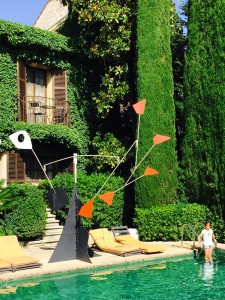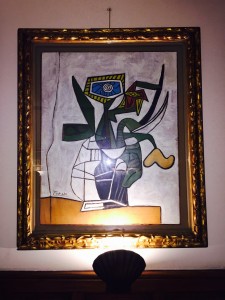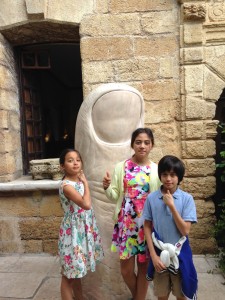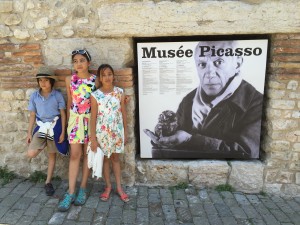As our family of five is wrapping up our mini-“Grand Tour” of London and the Continent, I find myself thinking again and again about the many highlights of our trip. Our visit to the “new and improved” Picasso Museum in Paris deserves a whole blogpost in and of itself, but, although it’s been almost a week, my mind is still reverberating from that transcendent visual onslaught and needs to regain some composure before I can even think about tackling it. Then I should also weave in our visit to the French Riviera, with the Picasso Museum in Antibes, the Picasso Chapel in Vallauris with the wartime L’Homme au Mouton (The Man with the Sheep, 1943) in the nearby square, Picasso’s gift to the town. But a more manageable place to start is our serene sojourn at La Colombe d’Or, our perennial base of operations in the south of France.
The Golden Dove is a wondrous small hotel in the high-walled medieval town of Saint-Paul de Vence, nestled in the hills about 6 km above the French Riviera. We had checked in late at night, only to be greeted upon awakening by the sweet sounds of a symphony of doves. Before breakfast we wound our way to the gorgeous pool and beheld the great Calder mobile, seated at the foot of the pool on its massive haunches:
A large green ceramic apple roosted along its length, which always reminded Casey and me of the first time our now 12-year-old Gina had visited. She was two at the time, and we had perched her atop the apple for a memorable photo op. Now even our 10-year-olds, Sofie and Noa, seemed too large for that roost, at least without hazarding the good graces of the proprietors, the family Roux. Anyway, a pittosporum now loomed over the apple and prevented perching, at least for any wingless biped.
Apart from enlargement of the odd shrub, this property seemed otherwise exactly as I remembered it. Which is a good thing, because it remained just exactly perfect. Architecturally it is neither opulent nor grand, but it is nonetheless gorgeous: a stucco villa with cozy public rooms and large suites, a beautiful dining terrace overlooking the verdant valley below, and tasteful stonemasonry and landscaping throughout. But what makes this hotel unique, all the more remarkable given its small size, is its world-class modern and contemporary art collection. I’ll of course begin–no surprise–by enumerating the Picassos: The highlight of the collection, rivaled only by the massive Calder, is a wonderful 1950’s canvas in the dining room, which unexpectedly surprised me upon first encounter and has never failed to thrill me since. And I’m not alone in that opinion, as I believe it is the only one of the many oils in the establishment that is displayed behind protective glazing:
In the hallway leading to the pool are two original prints, the 1952 Crâne de Chévre with a dedication by Picasso to M. Roux Grand-Père, and one of the nicer etching/aquatints from The 156 Series. I’ve always loved all three of them, and it just so happened that another impression of that goat became available (elsewhere) during our visit. I absolutely adore Picasso’s animals in general, as you may know, and I had been wanting to acquire this particular memento mori for years. I finally snapped up this coincidental impression not just for its own sake but also as a memento vitae of our trip. (OK, why don’t I just admit that that is just a boldfaced rationalization for acquiring a great but noncommercial Picasso that we’ll almost certainly be “stuck” with for years? Well, I certainly hope so!) Taking that amazing canvas home with us as well would have only added to our fine memories, but now one really shouldn’t be greedy. No doubt the Roux are sentimentally attached to it anyway, given the history of how it fell into their hands. Here is how it happened:
Picasso was a generous man, especially when it came to giving away his art, but in the case of La Colombe d’Or, there was ample precedent. Just about every room of the establishment, public and private alike, is chock full of paintings, prints and sculptures. As the story goes, the starving artists who dined chez Roux paid for their meals in art. Sounds nice, but by the time they chowed down on that lovely terrace, quite a number of them were already world-famous and hadn’t missed a meal in decades. Their more famous gifts include an excellent Miró canvas, a proper blue Yves Klein “body-brush” painting, a large mural after Léger on the terrace, and a huge César marble thumb just within the entrance. There are a whole bunch of Calder works on paper and a suspended mobile, and of course the seated monster with swinging arms. Between the Calder, the beautiful stonework, and the Mediterranean plantings, we all agreed it was the most beautiful pool ever. I won’t bother mentioning the mosaic, an unimpressive late Braque bird, on the wall behind the pool.
Between La Colombe d’Or and the rest of the Picassos, the Côte d’Azure was a splendid hors d’ouevre before arriving in Paris, where I might well have been the only crazed art lover to spend a solid week institutionalized at the Picasso Museum, if not for the many tween activities that drew my kids, just as the shopping sirens beckoned Casey. And, out of nowhere, even I had this nagging feeling that Paris might be hiding one or two other attractions, if only I could find them.




